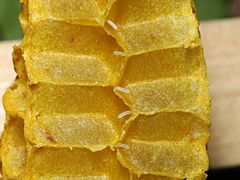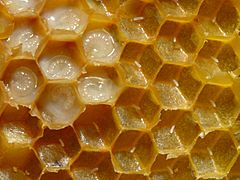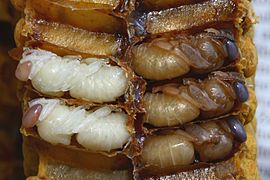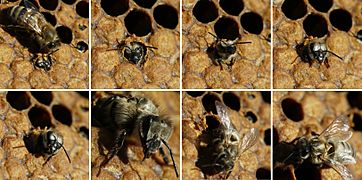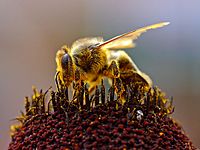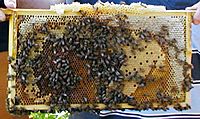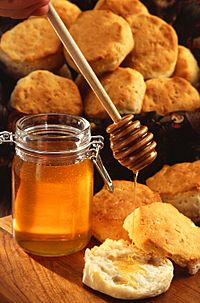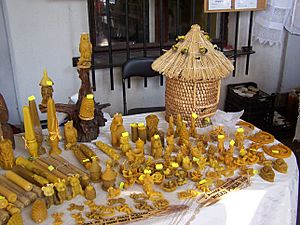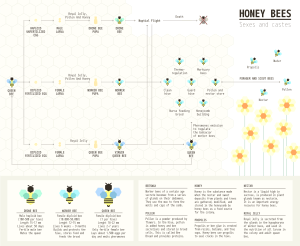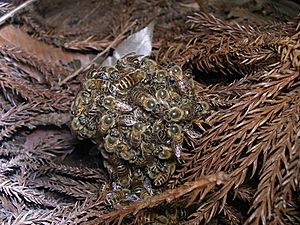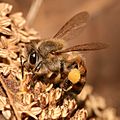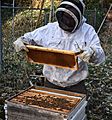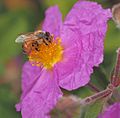Honey bee facts for kids
Quick facts for kids Honey bees |
|
|---|---|
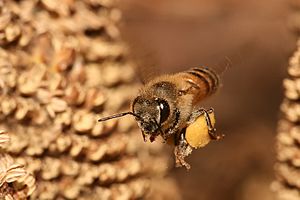 |
|
| European honey bee carrying pollen back to the hive | |
| Scientific classification | |
| Kingdom: | |
| Phylum: | |
| Class: | |
| Order: | |
| Family: |
Apidae
|
| Subfamily: |
Apinae
|
| Tribe: |
Apini
|
| Genus: |
Apis
|
| Species | |
|
|
A honey bee (or honeybee) is any bee that is a member of the genus Apis. They produce and store honey and make perennial, colonial nests from wax. They are in contrast with the stingless honey bee.
Honey bees are the only living members of the tribe Apini, all in the genus Apis. There are only seven species of honey bee, with a total of 44 subspecies. Historically, from six to eleven species have been recognized.
Honey bees are only a small fraction of the roughly 20,000 known species of bees. Some other types of related bees produce and store honey, but only members of the genus Apis are true honey bees. The study of honey bees is known as 'melittology'.
The first Apis bees appear in the fossil record at the Eocene–Oligocene boundary (34 million years ago (mya)), in European deposits. This shows that the bees were present in Europe by that time. Few fossil deposits are known from South Asia, the suspected region of honey bee origin.
No Apis species existed in the New World during human times before the introduction of A. mellifera by Europeans. Only one fossil species is known, a single 14-million-year-old specimen from Nevada.
The close relatives of modern honey bees – bumblebees and stingless bees – are also social to some degree.
Contents
Origin, systematics and distribution
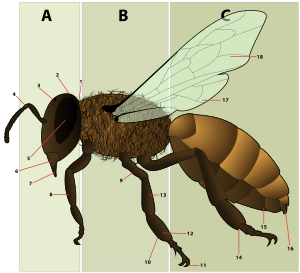
Honey bees appear to have their center of origin in South and Southeast Asia (including the Philippines), as all the extant species except Apis mellifera are native to that region. Notably, living representatives of the earliest lineages to diverge (Apis florea and Apis andreniformis) have their center of origin there.
The first Apis bees appear in the fossil record at the Eocene-Oligocene boundary (34 mya), in European deposits. The origin of these prehistoric honey bees does not necessarily indicate Europe as the place of origin of the genus, only that the bees were present in Europe by that time. Few fossil deposits are known from South Asia, the suspected region of honey bee origin, and fewer still have been thoroughly studied.
No Apis species existed in the New World during human times before the introduction of A. mellifera by Europeans. Only one fossil species is documented from the New World, Apis nearctica, known from a single 14 million-year-old specimen from Nevada.
The close relatives of modern honey bees – e.g. bumblebees and stingless bees – are also social to some degree, and social behavior seems a plesiomorphic trait that predates the origin of the genus. Among the extant members of Apis, the more basal species make single, exposed combs, while the more recently evolved species nest in cavities and have multiple combs, which has greatly facilitated their domestication.
Most species have historically been cultured or at least exploited for honey and beeswax by humans indigenous to their native ranges. Only two species have been truly domesticated: Apis mellifera and Apis cerana indica.
Honey bees are the only extant members of the tribe Apini. Today's honey bees constitute three clades: Micrapis (dwarf honey bees), Megapis (giant honey bee), and Apis (domestic honey bees and close relatives).
Life cycle
As in a few other types of eusocial bees, a colony generally contains one queen bee, a fertile female; seasonally up to a few thousand drone bees, or fertile males; and tens of thousands of sterile female worker bees. Details vary among the different species of honey bees, but common features include:
- Eggs are laid singly in a cell in a wax honeycomb, produced and shaped by the worker bees. Using her spermatheca, the queen can choose to fertilize the egg she is laying, usually depending on into which cell she is laying. Drones develop from unfertilised eggs and are haploid, while females (queens and worker bees) develop from fertilised eggs and are diploid. Larvae are initially fed with royal jelly produced by worker bees, later switching to honey and pollen. The exception is a larva fed solely on royal jelly, which will develop into a queen bee. The larva undergoes several moultings before spinning a cocoon within the cell, and pupating.
- Young worker bees, sometimes called "nurse bees", clean the hive and feed the larvae. When their royal jelly-producing glands begin to atrophy, they begin building comb cells. They progress to other within-colony tasks as they become older, such as receiving nectar and pollen from foragers, and guarding the hive. Later still, a worker takes her first orientation flights and finally leaves the hive and typically spends the remainder of her life as a forager.
- Worker bees cooperate to find food and use a pattern of "dancing" (known as the bee dance or waggle dance) to communicate information regarding resources with each other; this dance varies from species to species, but all living species of Apis exhibit some form of the behavior. If the resources are very close to the hive, they may also exhibit a less specific dance commonly known as the "round dance".
- Honey bees also perform tremble dances, which recruit receiver bees to collect nectar from returning foragers.
- Virgin queens go on mating flights away from their home colony to a drone congregation area, and mate with multiple drones before returning. The drones die in the act of mating. Queen honey bees do not mate with drones from their home colony.
- Colonies are established not by solitary queens, as in most bees, but by groups known as "swarms", which consist of a mated queen and a large contingent of worker bees. This group moves en masse to a nest site which was scouted by worker bees beforehand and whose location is communicated with a special type of dance. Once the swarm arrives, they immediately construct a new wax comb and begin to raise new worker brood. This type of nest founding is not seen in any other living bee genus, though several groups of vespid wasps also found new nests by swarming (sometimes including multiple queens). Also, stingless bees will start new nests with large numbers of worker bees, but the nest is constructed before a queen is escorted to the site, and this worker force is not a true "swarm".
Life cycle
-
A coloured dot applied by a beekeeper identifies the queen
Pollination
Species of Apis are generalist floral visitors, and pollinate many species of flowering plants. Of all the honey bee species, only A. mellifera has been used extensively for commercial pollination of fruit and vegetable crops. The value of these pollination services is commonly measured in the billions of dollars, adding about 9% to the value of crops across the world. However, while honey bees contribute substantially to crop pollination, there is debate about the potential spillover to natural landscapes and competition between managed honey bees and some of the 20,000 species of wild pollinators. Bees collect 66 pounds (30 kg) of pollen per year per hive.
Nutrition
Honey bees obtain all of their nutritional requirements from a diverse combination of pollen and nectar. Pollen is the only natural protein source for honey bees.
Pollen is also a lipid source for honey bees ranging from 0.8% to 18.9%. Lipids are metabolized during the brood stage for precursors required for future biosynthesis. Fat-soluble vitamins A, D, E, and K are not considered essential but have shown to significantly improve the number of brood reared. Honey bees ingest phytosterols from pollen to produce 24-methylenecholesterol and other sterols as they cannot directly synthesize cholesterol from phytosterols. Nurse bees have the ability to selectively transfer sterols to larvae through brood food.
Nectar is collected by foraging worker bees as a source of water and carbohydrates in the form of sucrose. Adult worker honey bees require 4 mg of utilizable sugars per day and larvae require about 59.4 mg of carbohydrates for proper development.
Honey bees require water to maintain osmotic homeostasis, prepare liquid brood food, and to cool the hive through evaporation. A colony's water needs can generally be met by nectar foraging as it has high water content. Occasionally on hot days or when nectar is limited, foragers will collect water from streams or ponds to meet the needs of the hive.
Beekeeping
Two species of honey bee, A. mellifera and A. cerana indica, are often maintained, fed, and transported by beekeepers. Modern hives also enable beekeepers to transport bees, moving from field to field as the crop needs pollinating and allowing the beekeeper to charge for the pollination services they provide, revising the historical role of the self-employed beekeeper, and favoring large-scale commercial operations.
Colony collapse disorder
Since 2007, abnormally high die-offs (30–70% of hives) of European honey bee colonies have occurred in North America. This has been dubbed "colony collapse disorder" (CCD) and was at first unexplained. It seems to be caused by a combination of factors rather than a single pathogen or poison, possibly including neonicotinoid pesticides or Israeli acute paralysis virus.
Bee products
Honey
Honey is the complex substance made when bees ingest nectar, process it, and store the substance into honey combs. All living species of Apis have had their honey gathered by indigenous peoples for consumption. A. mellifera and A. cerana are the only species that have had their honey harvested for commercial purposes.
Beeswax
Worker bees of a certain age secrete beeswax from a series of glands on their abdomens. They use the wax to form the walls and caps of the comb. As with honey, beeswax is gathered by humans for various purposes.
Pollen
Bees collect pollen in their pollen baskets and carry it back to the hive. In the hive, pollen is used as a protein source necessary during brood-rearing. In certain environments, excess pollen can be collected from the hives of A. mellifera and A. cerana. It is often eaten as a health supplement. It also has been used with moderate success as a source of pollen for hand pollination.
Bee bread
Worker bees combine pollen, honey and glandular secretions and allow it to ferment in the comb to make bee bread. The fermentation process releases additional nutrients from the pollen and can produce antibiotics and fatty acids which inhibit spoilage. Bee bread is eaten by nurse bees (younger workers) who then produce the protein-rich royal jelly needed by the queen and developing larvae in their hypopharyngeal glands.
Bee brood
Bee brood – the eggs, larvae or pupae of honeybees – is nutritious and seen as a delicacy in countries such as Australia, Indonesia, Mexico, Thailand, and many African countries; it has been consumed since ancient times by the Chinese, Egyptians, and Mayans.
Propolis
Propolis is a resinous mixture collected by honey bees from tree buds, sap flows or other botanical sources, which is used as a sealant for unwanted open spaces in the hive. Although propolis is alleged to have health benefits (tincture of Propolis is marketed as a cold and flu remedy), it may cause severe allergic reactions in some individuals. Propolis is also used in wood finishes, and gives a Stradivarius violin its unique red color.
Royal jelly
Royal jelly is a honey-bee secretion used to nourish the larvae. It is marketed for its alleged but unsupported claims of health benefits. On the other hand, it may cause severe allergic reactions in some individuals.
Sexes and castes
Honey bees have three castes: drones, workers, and queens. Drones are male, while workers and queens are female.
Drones
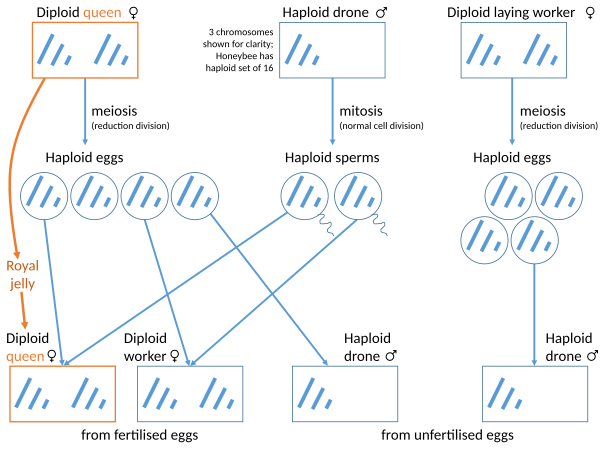
Males, or drones, are typically haploid, having only one set of chromosomes, and primarily exist for the purpose of reproduction. They are produced by the queen if she chooses not to fertilize an egg or by an unfertilized laying worker. Diploid drones may be produced if an egg is fertilized but is homozygous for the sex-determination allele. Drones take 24 days to develop, and may be produced from summer through to autumn, numbering as many as 500 per hive. They are expelled from the hive during the winter months when the hive's primary focus is warmth and food conservation. Drones have large eyes used to locate queens during mating flights. They do not defend the hive or kill intruders, and do not have a stinger.
Workers
Workers have two sets of chromosomes. They are produced from an egg that the queen has selectively fertilized from stored sperm. Workers typically develop in 21 days. A typical colony may contain as many as 60,000 worker bees. Workers exhibit a wider range of behaviors than either queens or drones. Their duties change upon the age of the bee in the following order (beginning with cleaning out their own cell after eating through their capped brood cell): feed brood, receive nectar, clean hive, guard duty, and foraging. Some workers engage in other specialized behaviors, such as "undertaking" (removing corpses of their nestmates from inside the hive).
Workers have morphological specializations, including the pollen basket (corbicula), abdominal glands that produce beeswax, brood-feeding glands, and barbs on the sting. Under certain conditions (for example, if the colony becomes queenless), a worker may develop ovaries.
Queens
Queen honey bees are created when worker bees feed a single female larvae an exclusive diet of a food called "royal jelly". Queens are produced in oversized cells and develop in only 16 days; they differ in physiology, morphology, and behavior from worker bees. In addition to the greater size of the queen, she has a functional set of ovaries, and a spermatheca, which stores and maintains sperm after she has mated. Apis queens practice polyandry, with one female mating with multiple males. The highest documented mating frequency for an Apis queen is in Apis nigrocincta, where queens mate with an extremely high number of males with observed numbers of different matings ranging from 42 to 69 drones per queen. The sting of queens is not barbed like a worker's sting, and queens lack the glands that produce beeswax. Once mated, queens may lay up to 2,000 eggs per day. They produce a variety of pheromones that regulate behavior of workers, and helps swarms track the queen's location during the swarming.
Defense
All honey bees live in colonies where the workers sting intruders as a form of defense, and alarmed bees release a pheromone that stimulates the attack response in other bees. The different species of honey bees are distinguished from all other bee species (and virtually all other Hymenoptera) by the possession of small barbs on the sting, but these barbs are found only in the worker bees.
The sting and associated venom sac of honey bees are also modified so as to pull free of the body once lodged (autotomy), and the sting apparatus has its own musculature and ganglion, which allows it to keep delivering venom once detached. The gland which produces the alarm pheromone is also associated with the sting apparatus. The embedded stinger continues to emit additional alarm pheromone after it has torn loose; other defensive workers are thereby attracted to the sting site. The worker dies after the sting becomes lodged and is subsequently torn loose from the bee's abdomen. The honey bee's venom, known as apitoxin, carries several active components, the most abundant of which is melittin, and the most destructive is phospholipase A2.
Defense can vary based on the habitat of the bee. In the case of those honey bee species with open combs (e.g., A. dorsata), would-be predators are given a warning signal that takes the form of a "Mexican wave" that spreads as a ripple across a layer of bees densely packed on the surface of the comb when a threat is perceived, and consists of bees momentarily arching their bodies and flicking their wings. In cavity dwelling species such as Apis cerana, Apis mellifera, and Apis nigrocincta, entrances to these cavities are guarded and checked for intruders in incoming traffic. Another act of defense against nest invaders, particularly wasps, is "body shaking," a violent and pendulum like swaying of the abdomen, performed by worker bees.
Gallery
-
Eastern honey bee (A. cerana) in Hong Kong
Images for kids
-
The European honey bee may have originated from eastern Africa. This bee is pictured in Tanzania.
-
Western honey bee on rock rose (Cistus) in Oakland, California
-
Western honey bee collecting pollen from turnip blossoms in Eastern Oklahoma
See also
 In Spanish: Apis (género) para niños
In Spanish: Apis (género) para niños




